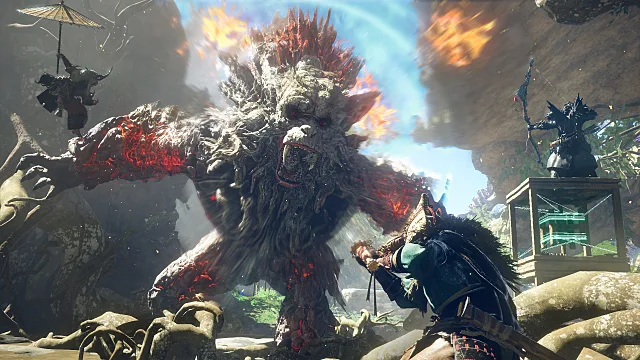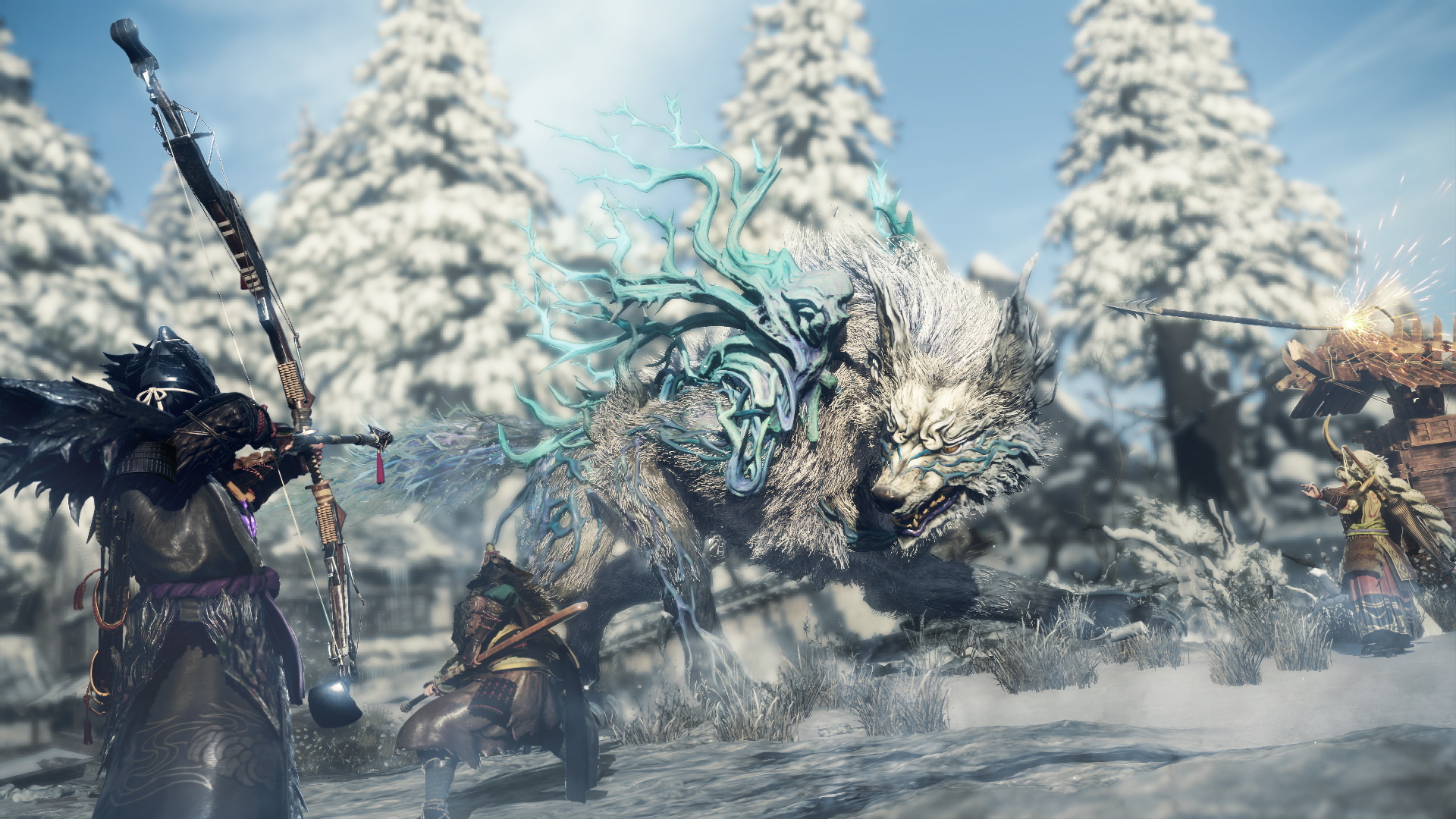EA and Koei Tecmo announced their new joint-venture project Wild Hearts not even a month ago, a Monster Hunter-like hunting game that pits tiny humans against massive beasts to tame the land and restore harmony to the human and natural worlds.
I recently had the pleasure of going hands-on with the hunting game’s early hours and seeing a bit of what Koei Tecmo has in store long after the prologue wraps up. While a few questions remain – namely regarding how interesting the open world will actually be – I came away excited about this fresh spin on an established genre and its combat innovations.
Wild Hearts tasks you, or a party of you and two others, with tracking down massive monsters and slaying them. That may sound identical to Monster Hunter, mostly because it is, but Wild Hearts will implement several changes to help distinguish itself. One of the most promising is its approach to multiplayer.
If Monster Hunter World burned you with its bizarre determination to make multiplayer as cumbersome as possible, rejoice. Wild Hearts players can join regardless of their progress in the main game without having to view cutscenes or reach certain milestones before missions become available. You can complete every main and side quest solo or with a party of friends, and combat difficulty scales to match the number of players present.
Wild Hearts’ underlying premise resembles Monster Hunter on the surface as well. Beasts of fantastical proportions face each other in catastrophic battles for territory, encroaching on civilization and all too willing to raze an entire settlement to the ground if it gets in their way.
Where the wyverns and other beasts of Monster Hunter are intertwined with nature on a conceptual level – changes in the balance of the environment send monsters into a frenzy, for example – Wild Hearts’ monsters, called Kemono, are intertwined with nature, a vital part of the fantasy setting Koei Tecmo and EA said they wanted at the center of Wild Hearts.
Your first Kemono, the Kingtusk, is a boar the size of a small hill and can command the earth itself to erupt under your feet or summon a torrent of deadly roots. Other Kemono EA showed during a preview trailer included an eagle with a volcano on its back, covering a field with blistering lava to narrow your movement options before sweeping in to attack, and a tree monkey with tails that resembled large berries, a Kemono so cute that I fervently hope we don’t have to fight it later.
On the bright side, if we do fight every monster, adorable or otherwise, at least Wild Hearts’ combat makes it worthwhile. The preview build featured a katana, bow, and umbrella, though the final version will include several more weapon types. Intriguing though the umbrella was, I stuck with the katana for ease of use and to satisfy my curiosity over how it compares to Monster Hunter’s Longsword, one of my favorites in Capcom’s franchise.
It turned out the blade’s length is the only passing similarity. Monster Hunter builds its Longsword around the spirit meter and a handful of combos tied to building and then using the meter. Fighting with it, like with most weapons in Monster Hunter, involves remembering a few button inputs and weaving combos together in what feels like an elaborate dance.
So far, combat in Wild Hearts feels deadlier and more fluid. The katana surprised me with how many opportunities opened up after using the basic attack, with at least three branching options and several special moves I could string together that turned my hunter into an unstoppable blade vortex.
Or they would have been unstoppable if I hadn’t just spun into a rock. Aiming attacks at this point feels as imprecise as it can be in Monster Hunter, which doesn’t fit quite as well with Wild Hearts’ movement and combat style. Still, the build EA provided was an early alpha. I’m sure plenty of changes are in store between now and launch; even in a somewhat rough state, combat in Wild Hearts seems full of promise.
Wild Hearts’ pace is faster than Monster Hunter – even your hunter moves faster – and it has a stronger effect on battles than you might expect. Fights with Kemono feel more intense, and better movement means you have more methods for responding to unexpected changes in the Kemono’s behavior and on the battlefield itself.
You can even climb Kemono to target their weak points, assuming you have the stamina for it. Where stamina in Monster Hunter lets you run away and depletes when you attack, Wild Hearts adopts a more traditional open-world approach, setting you loose in a vast landscape to track down clues, clamber over hills, and eventually corner your quarry.
Open worlds tend to make me wary, and I’m not entirely sold on Wild Hearts’ take on it yet. Size doesn’t naturally mean quality, and the admittedly short exploration segment in the preview build was a bit too linear and empty to get a good idea of Koei Tecmo’s vision for the final product.
What caught my interest more is how, at least in the few areas shown in the preview footage, Wild Hearts feels more lived in than most hunting games. Kemono flee, or follow you, in combat similar to Monster Hunter.
Where you might have to follow a Nargacuga from one forested location to another chunk of woodland, Kemono sometimes invade human spaces, such as the Kingtusk rampaging in a built-up viewing area constructed around an ancient cherry blossom tree. Having Kemono move out of the wilderness like this is a small but important feature that underpins your mission as a hunter and makes me hopeful that Koei Tecmo’s teases about an exciting, engaging story will turn out to be true.
One of the most exciting differences between Monster Hunter and Wild Hearts is crafting and the Karakuri you can make on the fly. Karakuri is a broad name for a staggering range of items you can make in Wild Hearts, items such as zip lines and human catapults, handy for reaching high places, along with walls, towers, and other architectural creations that let you shake up your approach to a fight and get a height advantage.
You learn new Karakuri patterns through defeating Kemono and, in the case of Fusion Karakuri, using the right combos in the right situations. Between construction Karakuri, weapon modification Karakuri, and even furnishing and decoration Karakuri, EA and Koei Tecmo said Wild Hearts has hundreds of possible combinations, and even they don’t know all the ways you can use these inventions, especially in a hunt.
That spirit of innovation sits alongside the kind of customization you expect from a game like this — hundreds of weapon variations, unique equipment suited for specific circumstances, and so on.
Wild Hearts has a lot going for it with its gorgeous fantasy setting and creative monster design, but this open-ended approach to combat and the fluid, satisfying feeling of battle itself are what sold me on the hunting game and have me eagerly awaiting its February 17, 2023, release date.










Published: Oct 10, 2022 11:10 am